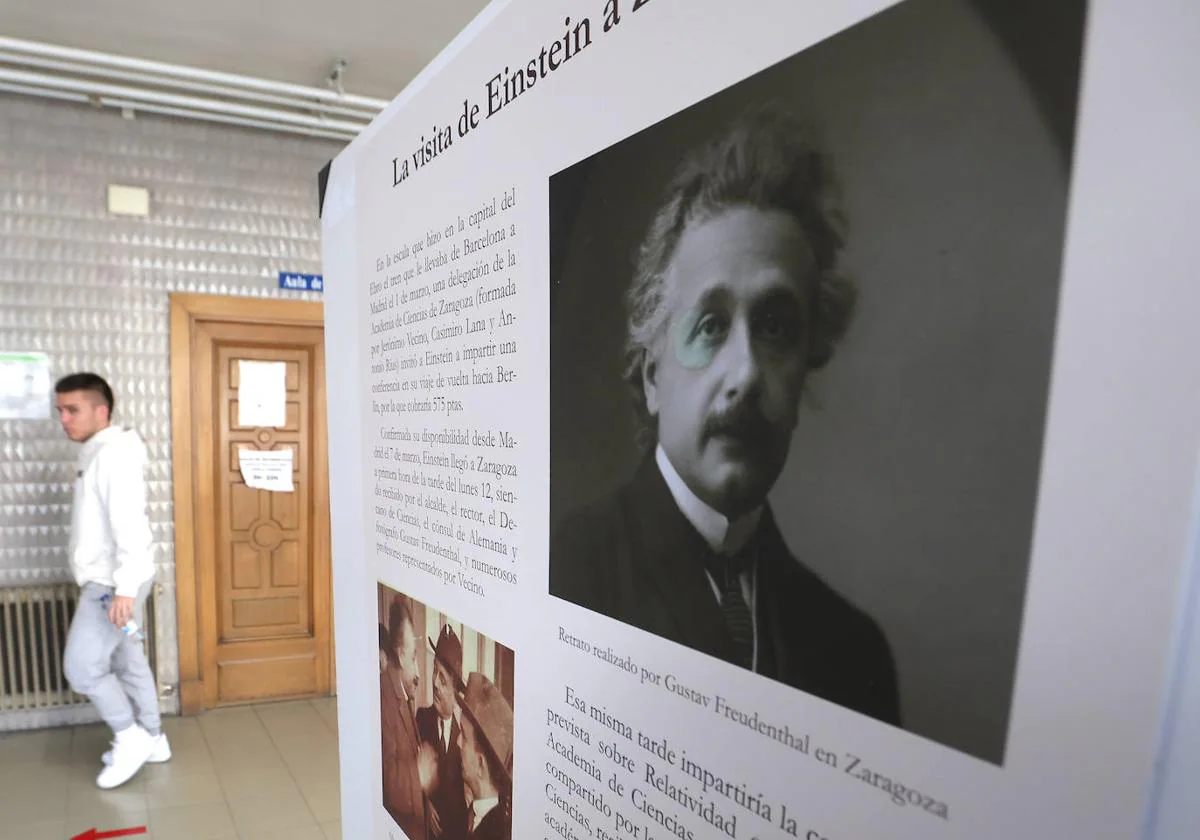The University of Salamanca commemorates the centenary of Albert Einstein’s visit to Spain (1923-2023) with a program of activities promoted by the faculties of Sciences and Chemical Sciences that began with the inauguration of the exhibition «Spanish Science before Einstein and relativity”, organized in collaboration with the UCCi USAL, FECYT and the Ministry of Science, Innovation and Universities. The exhibition collects the most relevant moments of the trip of the Nobel Prize in Physics through Spain, which served to consolidate the connection between Spanish science and the physics of the moment.
The inauguration was attended by José Miguel Mateos Roco, vice-rector for Research and Transfer of USAL; Antonio Miguel Martínez Graña and María del Mar Canedo, dean and dean of the faculties of Sciences and Chemical Sciences, respectively; and Francisco A. González Redondo, professor of History of Science at the Complutense University of Madrid and curator of the exhibition, among other academic authorities.
After the inauguration of the exhibition, which is free access and can be seen from Monday to Friday from 9 a.m. to 9 p.m. Until next March 15 at the Faculty of Sciences and Faculty of Chemical Sciences, the conference titled “Spanish Science before Einstein and relativity” took place by Francisco A. González Redondo himself.
Talk and Awards Ceremony of the Physics Olympiad
The next talk in the commemorative program is set for February 23, again in the same space. On this occasion, the turn will fall to the professor of the Department of Fundamental Physics of the University of Salamanca Marc Mars Lloret, who will give the conference “Gravitation and relativity: the Einsteinian revolution” at 5 p.m., after which the delivery will be held. of prizes from the local phase of the Physics Olympiad.
Exhibition «Spanish Science before Einstein and relativity»
In 1905 Albert Einstein would present Restricted Relativity (to Galilean reference systems) or Special Relativity and in 1915 he would establish the field equations of General Relativity, a new general theory of gravitation that would facilitate the study of the Universe. If throughout the 19th century they had been established as separable academic fields, Mathematics, Physics and Chemistry were needed and found again during the 20th century.
These revolutions in international physics coincide with what in Spain has been considered the Silver Age of our Culture; the period 1898-1936, during which three successive generations of scientists, those of ’98, ’14 and ’27, would aspire to scientific convergence with Europe.
Poster at the Albert Einstein exhibition. JM García
Once Albert Einstein’s visit to Spain was confirmed for the spring of 1923, the gaze of Spanish science at the time turned towards the emerging reference figure in physics at the time: the professor of Electricity and Magnetism at the Central University of Madrid, Blas Cabrera Felipe, elected academic of Sciences in 1909 and appointed director of the Physical Research Laboratory of the Board for Expansion of Studies in 1910.
Cabrera was the first to refer to Einstein and relativity in a conference given at the Zaragoza congress of the Spanish Association for the Progress of Sciences in 1908 on “The theory of electrons and the constitution of matter”, although in his entrance speech at the Royal Academy of Sciences of Madrid in 1910 he continued talking about “The ether and its relations with matter at rest.”
Before the 1921 Nobel Prize in Physics was confirmed, Albert Einstein had begun his world tour from Germany in October 1922 to Japan, passing through Singapore on his return to Europe, stopping in Palestine for two weeks and , from there, to France on the way to Spain.
In summary, it must be noted that few people could understand Einstein. Nor did his visit represent a change in the institutional structures of Spanish physics and mathematics. But a spectacular increase in society’s perception of the value of science was achieved, undoubtedly an essential collaboration in the process of European convergence that it entailed.
